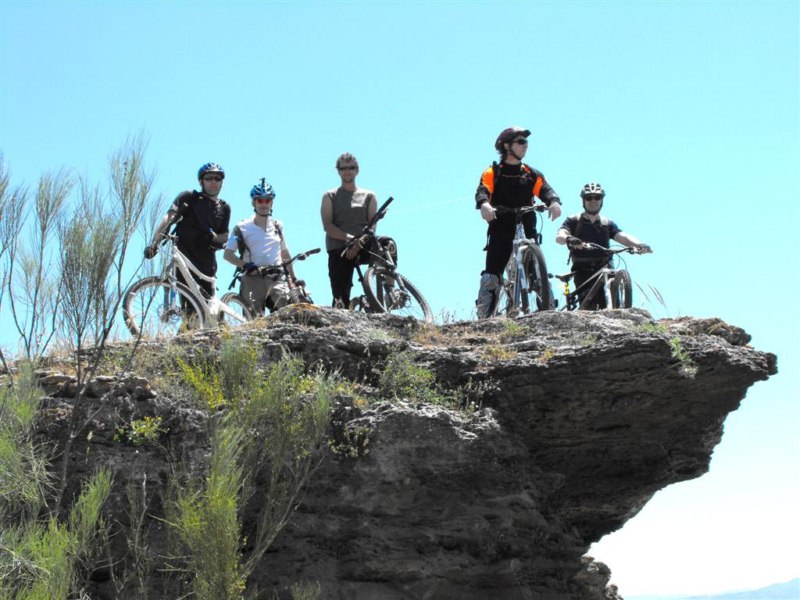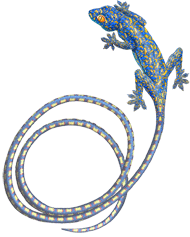Finca la Campana in el chorro is perfectly situated to offer both the tranquility of a rural mountainous setting and easy access to the rich bustling culture of Malaga, Sevilla Granada and Cordoba. A large number of varied activities and attractions are available in the area, details of which can be seen by clicking on the links to the left.
For further information, please see an extensive list of related websites on the links page.
On The Doorstep
There are many interesting places to visit in the local area, many of which can be reached by foot.
- Ruinas de Bobastro - just 45 minutes walk from the Finca are the ruins of bobastro carved out of the sandstone they make for an impressive spectacle. Despite its scale (little more than 16m by 10m) the rock church of Bobastro is a unique archaeological site. Along with (arguably) the Church of Santa de Melque in Toledo, it’s one of the only churches in Spain that can truly be considered an entirely ‘Mozarab’ structure. Alongside the remains of the walls of the church, there’s a crypt, and, elsewhere around the site, a cemetery and then… only scattered pieces of an intriguing jigsaw puzzle – tantalizing hints of what once stood there – remain of the rest of Bobastro.
- Los Pantanos del Chorro - 15 minutes drive from la Campana, this 3 wonderfull lakes invites for swimming, kayaking and fishing. Unspoilt nature little islands and hidden beaches.

- El Mirador - one of El Chorro's most popular and family-friendly restaurants lies just a few mintutes up the hill towards the lakes.
- Natural Parks - Finca la Campana is surrounded by four protected National Nature Parks Parque Natural de El Chorro 'Montes De Malaga', 'Torcal de Antequera', and 'Sierra De Las Nieves', and benefits from stunning views of their dramatic landscape and rich plant and animal life.

Malaga City
In the city of Malaga you can find many places of historic and cultural interest. Short descriptions of some of the more popular attractions are listed below:
- La Alcazaba - an immense 11th century Moorish military fortress built on the remains of a Roman fortress. It lies on a hilltop above the city and offers excellent views over the sea. Opened 9:30 - 8pm in Summer (7pm in winter), 952 227230.
- The Picasso Museum - near to the site of Picasso's birthplace at the Plaza de la Merced. Visitors may like to take advantage of the free opening every last Sunday of the month. Open 10am - 8pm (9pm fri & sat), 952 127600.
- Malaga Cathedral. Built on the site of the former main mosque, construction began in the 16th century and was completed some 200 years later, with the exclusion of the Southern tower, when the funding was diverted to the Spanish Campaign in the American War of Independence. This has led to its nick name 'La Manquita' which means the one-armed. The Cathedral and associated museum are ope 9 - 7pm (6pm saturdays) museum closed on Sundays and public holidays, 952 220345.
- Malaga Centre for Contemporary Art - the major cultural centre for modern art in Southern Spain, houses a temporary and permanent collection including works by international artists such as Alex Katz and Louise Bourgeois. Open 10am - 2pm, 5pm - 9pm (8pm off-season), 952 120055.
- Museo de Artes Populares - intriguin exhibits relating to traditional life in the area. Open 10am - 1:30pm, 5pm - 8pm (4pm - 7pm winter) (Closed Sat afternoons & Sundays), 952 217137 .
- Roman Amphitheatre - from the 3rd century, situated at the foot of La Alcazaba, 951 041400.
- La Malagueta - the Malaga Bull Ring and associated museum open 10am - 1pm, 5 - 8pm Mon - Fri, 952 221727.
- Kelipe Centro de Arte Flamenco - intimate show of Traditional Flamenco by husband and wife. 9pm - 10pm Thu - Sat, 692 829885.
- La Concepcion - Historic Botanical Gardens of Malaga, situated just at the bottom of the hill, open 9:30am - 8:30pm (5:30 in winter) closed Mondays, 95 2252148.
- Feria de Malaga - Malaga's 9-day festival at the start of August. It begins with a great firework display at midnight on Friday, and the city is filled with music and dancing, fun fairs and nightly concerts.
- Historic Botanical Gardens of Malaga 'La Concepcion' is situated just at the bottom of the hill. Originally owned by Marquis Jorge Loring Oyarzabal and Amalia Heredia Livermore, and tended by the prize-winning French gardener Chamousst, this 19th century romantic garden boasts over a thousand species of exotic plants, as well as ancient Roman statues and a magnificent house. Open 9:30am - 8:30pm (5:30 in winter) closed Mondays, 95 2252148.
Around Malaga
There are many other towns and villages nearby well worth exploring. These include...
- Mijas - a typically Andalusian white-washed village located at a mountain side about 450 m above ea level, in the heart of the Costa del Sol. There are some local history museums and many souvenir shops, Mijas also has seven golf courses including La Cala Resort, the biggest golf resort in Spain.

- Ronda - located about 100km Northwest from the city of Malaga in a mountainous region, Ronda is famous for its 3 beautiful bridges that span the breathtaking 100m tall canyon upon which the city perches. (see image to the right.)
- Torremolinos - a poor fishing village before the growth in tourism beginning in the late 1950s, Torremolinos was the first of the Costa del Sol resorts to develop.
- Nerja - hosts one of Spain's major tourist attractions, a series of caverns which stretch for almost 5 km. Concerts are regularly held in one of the chambers which forms a natural amphitheatre.
The Romans built here three settlements, including Detunda, of which now large remains can be seen. The area was later taken over by the Arabs in the early 8th century. Under the Moors, the town was known as Narixa, which means "abundant spring", from which the present name derives. The Balcon de Europa, a mirador or viewpoint which gives stunning views across the sea, is in the centre of the old town.
Nerja has several beaches set in coves beneath cliffs. It is also becoming a significant centre for walkers, thanks to the mountain scenery of the nearby Sierra de Almijara and Sierra Tejeda. The Sierra de Burno overlooks the town. Nerja is also the centre of scuba diving on the Costa del sol, with the Natural Park of Maro - Cerro Gordo nearby. - Marbella - One of the most popular tourist resorts along the Costa Del Sol, Marbella is considered a very upmarket destination, with many famous local residents. It is a major destination for luxury cruise ships and mega yachts which are also often docked in its harbour. The area around Marbella is particularly popular with those who like golf.
- Montes de Malaga - This zone of medium-height mountains constitutes a natural space with a great many torrents of water which have created deep gorges and sheer drops. At the heart of this mountain mass is the Montes de Málaga Natural Park. The most characteristic native species are the genet, badger, fox and skunk, together with a considerable number of long-tailed newts. Among the birds of prey are the eagle, sparrowhawk and goshawk.
- Estepona - renowned for its beaches, which stretch along some 21 km of coastline, Estapona also has many other interesting facets which make it a popular and contemporary all year round holiday destination including two EC Blue Flag beaches, a modern sports marina with many tapas bars and restaurants and a white-walled town offering shopping and picturesque squares.
- Granada - is placed at the foot of the Sierra Nevada mountains, at the confluence of three rivers, Beiro, Darro and Genil, at an elevation of 738 metres above sea level yet only one hour from the Mediterranean coast, the Costa Tropical. Nearby is the Sierra Nevada Ski Station, where the FIS Alpine World Ski Championships 1996 were held. The Alhambra, a Moorish citadel and palace, is in Granada. It is one of the most famous items of the Islamic historical legacy that makes Granada a hot spot among cultural and tourist cities in Spain.
- Gibraltar - a British overseas territory located on the southern end of the Iberian Peninsula at the entrance of the Mediterranean. Evidence of Neanderthal habitation in Gibraltar between 128,000 and 24,000 BCE has been discovered at Gorham's Cave, making Gibraltar the last known holdout of the Neanderthals. The semi-wild Barbary Macaques form an integral part of Tourism in Gibraltar.
- Tangier, Morocco - lies on the North African coast at the western entrance to the Strait of Gibraltar where the Mediterranean meets the Atlantic Ocean off Cape Spartel. The history of Tangier is very rich due to the historical presence of many civilizations and cultures starting from the 5th century BC. The city is currently undergoing rapid development and modernization. Projects include new 5-star hotels along the bay, a modern business district called Tangier City Centre, a new airport terminal and a new soccer stadium.
Beaches
Locally accessible beaches include
- Malaga - just 5 minutes walk from the city centre
- San Julian - Beautiful, clean beach only a 60 minute drive from the house.
- Torremolinos - Popular with the tourists since the 70s, this beach is typical of a busy Costa-del-Sol resort.
- Nerja - about 50 km east of Malaga, Nerja has several beaches set in coves beneath cliffs.
- Marbella - including Playa de la Bajadilla, Playa de Fontanilla, and Puerto Banus, a marina built by Jose Banus where Rolls-Royces and Ferraris meet yachts.
- Fuengirola - a major tourist resort, with more than 8 km of beaches, and home to a medieval Moorish fortress
Bird Watching
As the name of the house suggests, springtime brings numerous nesting swallows to these mountains which you can see swooping and swirling in the valley. Andalucia is also home to 13 raptor species. You can spot the rare black vulture in the Sierra Morena region, the Spanish Imperial eagle in the Parque Naciónal de Doñana, and in many mountain regions the golden eagle,the Egyptian and griffon vultures, and smaller birds of prey, such as the kestrel, buzzard, various harriers and red kite.

The best time of year to bird watch in Andalucia is the spring, when you can see many wintering species, as well as those arriving for the summer months.
For more information about bird watching in Andalucia, click here.
Walking
Andalucia contains 12 Vias Verdes - disused railway tracks that have been converted into walking/cycling routes. They are clearly signposted and dotted with picnic spots and viewpoints and well as information displays giving the history of each route. For details of each, click here.
The GR7 (Gran Recorrido 7) is a 1,250km footpath based on an ancient trade route and forms part of the European Route No. 4 which stretches from Tarifa, accross the continent to Greece. It specifically avoids tarmac roads and traffic, and is sign posted by red and white markers. For mor information see the Wikipedia Page and associated links.
Six other suggested walks within the area can be found here.
Cycling

Andalucia is renowned for its excellent cycling conditions, and welcomes numerous professional teams every year for training. The area can offer the following benefits:
- Great climate all year round.
- Extensive established cycle routes
- Low trafic density
- Excellent road surfaces
- Hills of Montes de Malaga and The Sierra Nevada
- Breath-taking scenery.
- Bike shops and suppliers in the area.
Fishing
It is posible to take part in salt water and fresh water fishing in Andalucia. The region's nature parks are home to 64 fishing preserves, where trout, pike, carp and black bass can be found. The most popular location for trout fishing is Rio Frio which lies between granada and Malaga, where brown trout of up to 5.2kg have been recorded.
Both the Atlantic and Meditteraean coastlines provide great shore fishing, and you can find many opportunities for open sea fishing along the coastline, particularly for Swordfish July - September. Manilva is paticularly popular due to the rich abundance of sea life.
For more information please see Andalucia fishing information.












